Elsevier Encyclopedia of Geology - vol I A-E
Подождите немного. Документ загружается.


Some hazards are natural, others are purely
anthropogenic, and many have both natural and
anthropogenic causal elements.
There is a need to consider geohazards from a
sociological as well as a scientific viewpoint, as the
perception and response of the local populace and
all tiers of government are as important as tech-
nological understanding. Geohazards can also only
be successfully evaluated with a full interdisciplin-
ary approach: an international, possibly even a
global, approach is also called for.
Definitions
There are two published definitions of geohazards.
A geohazard is a hazard of geological, hydrological
nature which poses a threat to Man and his activities.
(McCall & Marker 1989)
and
A geohazard is one that involves the interaction of man
and any natural process on the planet. (McCall and
others 1992)
The second is wider, but the first brings in the
essential element of human vulnerability, which is
well expressed by MR Degg in his diagram for
the disaster equation (Figure 1) – the relationship
between the hazard, disaster, and vulnerability. The
larger and more severe the event and the more vulner-
able the population, the greater the disaster; there is
a threshold below which there is no disaster. If
there are no human’s present, strictly speaking there
is no hazard.
The words ‘hazard’ and ‘risk’ are often used inter-
changeably, but the risk is a quantification. RJ Blong
defined ‘risk’ as the product of ‘hazard’ and ‘vulner-
ability’. The word ‘disaster’ refers rather loosely to
the consequence of hazards.
Types of Natural Geohazard
RJ Blong lists the following as the principal natural
geohazards:
.
earthquakes (r);
.
volcanic eruptions (r);
.
landslides (r);
.
tsunamis (r);
.
subsidence (s);
.
coastal erosion (s);
.
coastal progradation (s);
.
soil erosion (s);
.
expansive soils (s).
Already, we see two distinct classes of geohazard:
the rapid-onset, intensive hazards (r) and the slow-
onset, pervasive hazards (s). Attention has been trad-
itionally focused by scientists, the media, and the
populace on the former, but the latter can be equally
damaging.
SA Thompson separated ‘natural geohazards’ from
‘meteorological hazards’:
.
cyclones;
.
tornadoes;
.
floods;
.
heatwaves;
.
thunderstorms and gales.
All of these have some geological consequences,
especially the first three.
GJH McCall later added to the list and separated
those that are potentially catastrophic and cannot
at present be reliably predicted, unless in general
terms or not at all. These can be treated mainly by
emergency planning, warning systems, education
and communication, and evacuation. Mitigation
and prevention procedures are of limited application.
The list is:
.
earthquake hazards (e.g., Kobe 1995);
.
volcanic hazards (lava, pyroclastic flows, nue
´
es
ardentes, ash falls, lahars, blasts, and gas releases)
(e.g., Etna, Martinique, Montserrat, Nevado del
Ruiz 1985, Lake Nyos 1986);
.
tsunamis (related to either of the above) (e.g., Hilo,
Hawaii, 1960);
.
extraterrestrial impacts (e.g., Tunguska 1908).
Figure 1 The ‘disaster equation’. After Degg MR, in McCall
GJH and Marker BR (1989)
Earth Science Mapping for Plan-
ning, Development and Conservation, Engineering Geology Special
Publication No. 4
. London: Kluwer.
516 ENGINEERING GEOLOGY/Natural and Anthropogenic Geohazards

The remainder can be reasonably counteracted by
engineering procedures at a cost. The list is:
.
mass movements (landslides, avalanches, debris
flows, ice-related movements) (e.g., Ventnor, Swiss
Alps, Cotopaxi, Cordillera Blanca);
.
subsidence (swallow holes, karstic processes,
gypsum-related sink holes, sinking cities) (e.g., Pen-
nines, Wuzhan, Ripon, Venice);
.
flooding after abnormal rainfall and cyclones (Ban-
gladesh);
.
coastal erosion (sea-level rise) and coastal progra-
dation (China, Burma);
.
riverbank failure and silting up of rivers (Missis-
sippi River);
.
expansive and collapsing soils, thixotropic sands
(e.g., Anchorage in Alaska);
.
permafrost (e.g., Canada, Siberia);
.
hazardous gas emission (radon) (e.g. Cornwall).
A third category was listed of those that fall be-
tween the two:
.
combustion and wildfire (e.g., Australia);
.
neotectonic deformation and fissuring (e.g., Xian);
.
desertification (e.g., Sahel).
K Hewitt and I Burton, in 1975, published a list of
parameters for ‘selecting’ hazard events:
.
property damage extending to more than 20 fam-
ilies, or economic loss (including loss of income, a
halt to production, costs of emergency action) in
excess of US$50 000;
.
major disruption of social services, including com-
munications failure and closure of essential facil-
ities of establishments of economic importance;
.
a sudden, unexpected or unscheduled event, or
series of events, which puts excessive strain on es-
sential services (police, fire service, hospitals, public
utilities) and/or requires the calling in of men,
equipment, or funds from other jurisdictions;
.
an event in which 10 or more persons are killed or
50 or more injured.
Such quantification of thresholds is applicable to
rapid-onset, intensive hazards, but of little use for the
slow-onset, pervasive hazards, such as karstic pro-
cesses or coastal erosion. Also, it appears to be ap-
plicable to developed countries, but of little relevance
to less developed countries, such as islands in the
Pacific Ocean. Monetary loss and body count alone
are thus poor indicators of the magnitude of an effect
of a hazard on an afflicted community. Vulnerability
should take into account not merely the risk, but
also the endemic conditions inherent in the society.
Deaths due to starvation consequent on hazards are
not considered in this scheme.
SA Thompson, in 1982, produced a table com-
bining frequency with deaths per event (Table 1).
This table shows that earthquakes and cyclones
are the most lethal per event on a global scale and
both are of high frequency; however, flooding,
because of its very high frequency, is nearly as
lethal. The low frequency and number of deaths
per event for landslides can be misleading – for
example, in Basilicata, Italy, virtually all of the
dense cluster of hilltowns are threatened by land-
slides, and it is unquestionably a major hazard,
even if not a great killer. Likewise, in Nepal and the
Pamirs (Figure 2), the steep topography means that
landslides repeatedly wipe out villages and com-
munications and present a major and intractable
hazard problem.
SA Thompson also produced a table of fatalities
covering Asia and Australasia between 1947 and
1981, showing how regional statistics can reveal
extraordinary contrasts (Table 2). Asia had 85.8%
of the global count of 1 208 044 global deaths
from the hazards listed in Table 2 during this
period. However, this figure is a combination of
both geological and meteorological disasters, and,
for the geological disasters, the figure is slightly
below the global average. Australasia accounted
for only 0.4% of the global deaths. The death counts
and magnitude of the event cannot be correlated,
because of factors such as variations in populat-
ions at risk, ground conditions, and building con-
struction quality and type. In the case of volcanic
eruptions, there is a wide variation in the expected
magnitude and type of eruption according to the
classification of the volcano and its petrological
products.
Volcanoes and earthquakes are covered by separate
entries in this encyclopedia (see Tectonics: Earth-
quakes, Volcanoes).
Table 1 Frequency of hazards and deaths per event. From
Thompson SA (1982)
Hazard
Hazard
frequency
%
frequency
Deaths
per event
Geological hazards
Landslides 29 2.7 190
Tsunamis 10 1.0 856
Volcanoes 18 1.7 525
Earthquakes 161 15.2 2652
Meteorological hazards
Cyclones 211 19.9 2373
Tornadoes 127 12.0 66
Floods 343 32.3 571
Heatwaves 22 2.1 315
Thunderstorms and gales 36 3.4 587
ENGINEERING GEOLOGY/Natural and Anthropogenic Geohazards 517
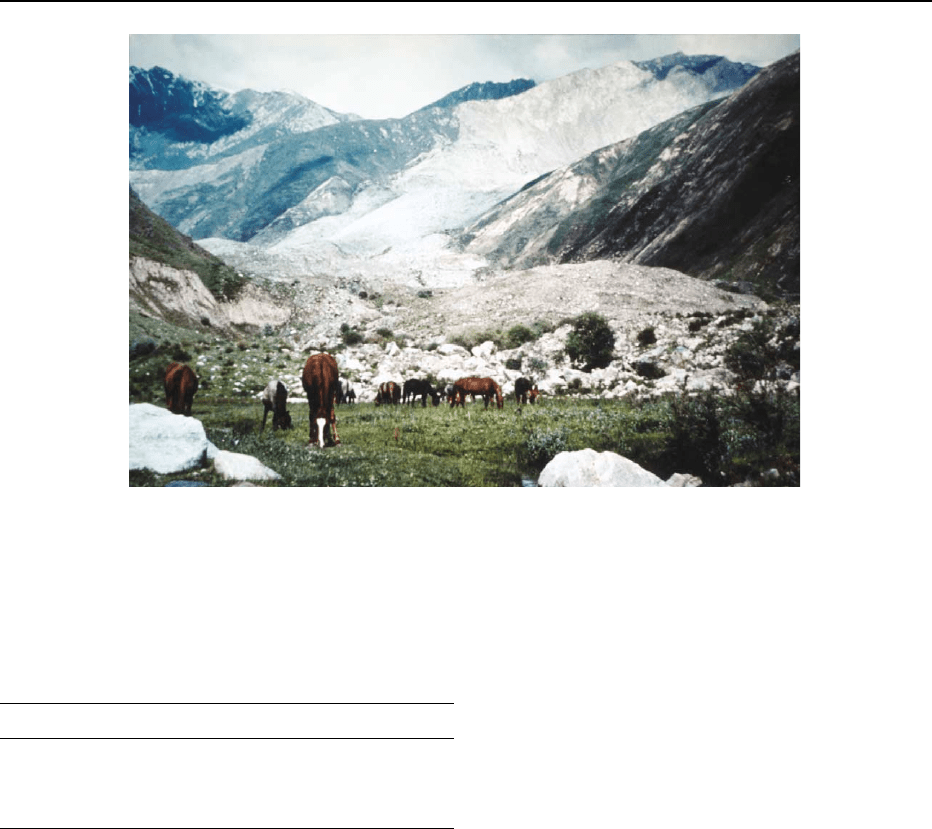
Procedures for the Mitigation of
Natural Hazards
These include:
.
the study of existing conditions and evidence of
past activity, including mapping;
.
prediction in time and space (when?, where?, and
on what scale? risk assessment);
.
prevention or mitigation by engineering or other
methods;
.
planning of land use;
.
monitoring and installation of warning systems;
.
emergency planning; proactive, including planning
for evacuation; post-event relief.
Each of the above will have variable relevance to
a particular hazard and subject site/area/region, and
may have none at all.
Types of Anthropogenic Geohazard
JD Mather and others included:
.
surface movements – subsidence (Figure 3) related
to mineral or fluid (hydrocarbon, water) extraction
and surface collapse into voids left by mineral
workings;
.
contaminated land – left by mineral workings,
chemical plants, gas works, etc. (‘brownfield sites’);
.
rising groundwater levels;
.
modification of groundwater quality (unsewered
sanitation, organic solvent pollution);
.
waste disposal.
GJH McCall and others also included:
.
loss of soil and agricultural land (including the
effects of urbanization on the soil resource);
.
reduction in biodiversity.
The anthropogenic hazards are mostly of long
build up – even surface collapses due to old mine
workings (Figure 4), which appear abruptly without
warning, as the roof of the mined-out cavity gradually
moves towards the surface due to the fall-out of
blocks.
Three of these quiet, pervasive, slow build-up
hazards are mentioned below to illustrate this type
of geohazard.
Figure 2 Beneath this peaceful scene in the Pamirs, Tadzhikistan, is buried Xait, one of 33 villages buried by landslides triggered
by earthquakes in 1948, with 50 000 lives lost which geological knowledge could have saved. de Mulder EFJ, Holland, International
Union of Geological Sciences ‘COGEOENVIRONMENT’ photograph.
Table 2 Fatalities per event in Asia and Australasia. From
Thompson SA (1982)
Event Asia Australasia
Landslides 3576 0
Tsunamis 7864 44
Volcanoes 2806 4000
Earthquakes 33 3623 133
518 ENGINEERING GEOLOGY/Natural and Anthropogenic Geohazards

Rising Groundwater
Rising groundwater was described in 1992 by DJ
George – a problem that has affected many cities in
the Middle East (Kuwait, Doha,Cairo, Riyadh, Jeddah,
Madinah), and is a major hazard in terms of cost, and
loss of and injury to human life. A typical cause is the
installation of new water supply systems piped in from
outside a city area, which previously relied on numer-
ous small wells within it. The water table under the city
is no longer utilized and the water table rises. This
produces:
.
damage to buildings and structures;
.
damage to services and roads;
.
overloading of sewer systems and treatment
plants;
.
salting and waterlogging of soils;
.
public health hazards.
This is essentially anthropogenic but, like all such
hazards, is due to interference with the natural
system.
Sea-Level Change on the China Coast
S Wang and X Zhao covered this hazard, which
is likely to become more significant with global cli-
mate change – warming related to the ‘greenhouse
effect’–which has now been shown to have been
unquestionably influenced since the beginning of the
Industrial Age (see summary report by McCall GJH
(2003); Solar System: The Sun). On the long, sinuous,
and island-dotted coast of China, there are many
large, industrialized cities and regions – e.g., Shang-
hai, Tianjin, Guangzhou – located on coastal plains
and deltas. The evidence reveals a complex picture of
overall oscillations of the order of a thousand years
and different effects of Quaternary crustal move-
ments, up and down in different regions; however,
subtracting the latter, a general rise of 0.65 mm per
year has been recognized. A future rise of several
centimetres, which is predicted (also allowing for
the effect of global warming), will have disastrous
effects on the coastal and coastal hinterland environ-
ment and the industry and agriculture there. The
wetlands will be inundated. Engineering construc-
tions proposed in the Yangtze delta will be under the
following main headings:
.
control of land subsidence due to human activity;
.
prevention of seawater seepage and windstorm tides;
.
drainage of low-lying land and land improvement;
.
taking into account sea-level rise in planning new
urban areas.
Global Soil Loss: Biodiversity Loss
WS Fyfe has emphasized the fact that the explosive
growth of the human population (a taboo subject as
WI Stanton has emphasized) (Figure 5) is at the root
of most of the quiet, pervasive hazards. He indicates
that topsoil loss is occurring at a global rate of 0.7%
per year. The global climate bioproductivity is vital
to the functioning of the global thermostat, and
species continue to be wiped out wholesale due to
the activities of humankind.
As described by GJH McCall et al., in an original
definitive account, urban geohazards are becoming
more and more significant as urbanization mush-
rooms in the early twenty-first century (Figure 6).
These include natural and anthropogenic hazards.
Hazard and Risk Mapping
JG Doornkamp, in 1989, published a concise account
of hazard mapping. He covered:
.
landslips and avalanches;
.
natural ground subsidence;
Figure 3 Leaning church tower due to differential settlement in
soft Holocene sediments, a foundation problem near Lake Ijssel,
The Netherlands. de Mulder EFJ, Holland, International Union
of Geological Sciences ‘COGEOENVIRONMENT’ photograph.
ENGINEERING GEOLOGY/Natural and Anthropogenic Geohazards 519
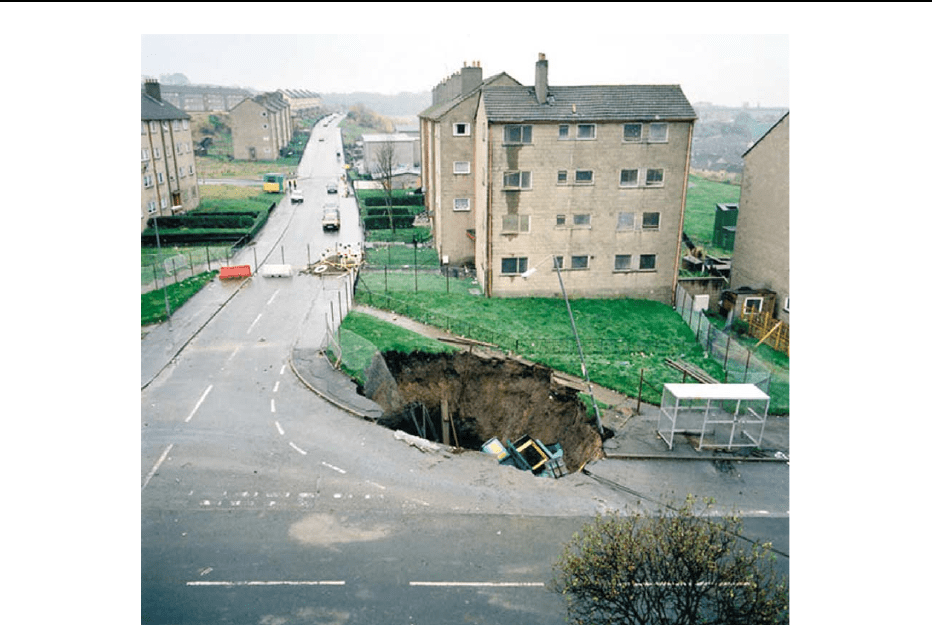
.
hazards of quarrying and mining;
.
erosion and deposition;
.
flooding;
.
saline soils;
.
permafrost;
.
seismological hazards;
.
volcanic hazards.
The third in this list is an anthropogenic hazard –
the general principles apply to both natural and an-
thropogenic hazards. JG Doornkamp noted that the
distinction is ambiguous.
Every hazard has three key properties:
.
magnitude;
.
frequency;
.
location.
The last of these is most amenable to mapping.
Mapping may be taken for different reasons:
.
to define the nature and extent of a historical event;
.
to define the nature and extent of a recent event;
.
to define present conditions in order to assess the
likelihood of a recurrent event.
The social and economic content of the affected
subject must be included in any such programme.
A hazard cannot in itself be mapped, as it is a process.
Rather, the results of a hazard are mapped. The re-
sultant landforms, the effects on soil and rocks, and
the effects on constructions are mapped.
JG Doornkamp devised a useful diagram showing
the context of hazard mapping (Figure 7).
Aids to mapping include:
.
satellite imagery;
.
airborne multispectral scanning;
.
photogrammetry;
.
shallow geophysics;
.
global positional systems.
DKC Jones has illustrated well the procedures in
hazard mapping in an account of the application to
landslides. The graphical methods are only part of the
exercise, which includes:
.
graphical methods, mainly involving mapping;
.
the analysis of the empirical relationships be-
tween landslides and individual causal factors,
such as slope steepness, material type, vegetation
cover, rainfall intensity, and human constructions;
.
multivariate analysis of the causes of landslides.
True hazard maps display the extent of past haz-
ardous events (zoned), together with an internal div-
ision reflecting the magnitude frequency distribution
Figure 4 The result of a void migrating to the surface in old mine workings beneath a suburb of Glasgow. British Geological Survey
photograph, in McCall GJH, de Mulder EFJ, and Marker BR (1996) Urban Geoscience. Rotterdam: Balkema.
520 ENGINEERING GEOLOGY/Natural and Anthropogenic Geohazards
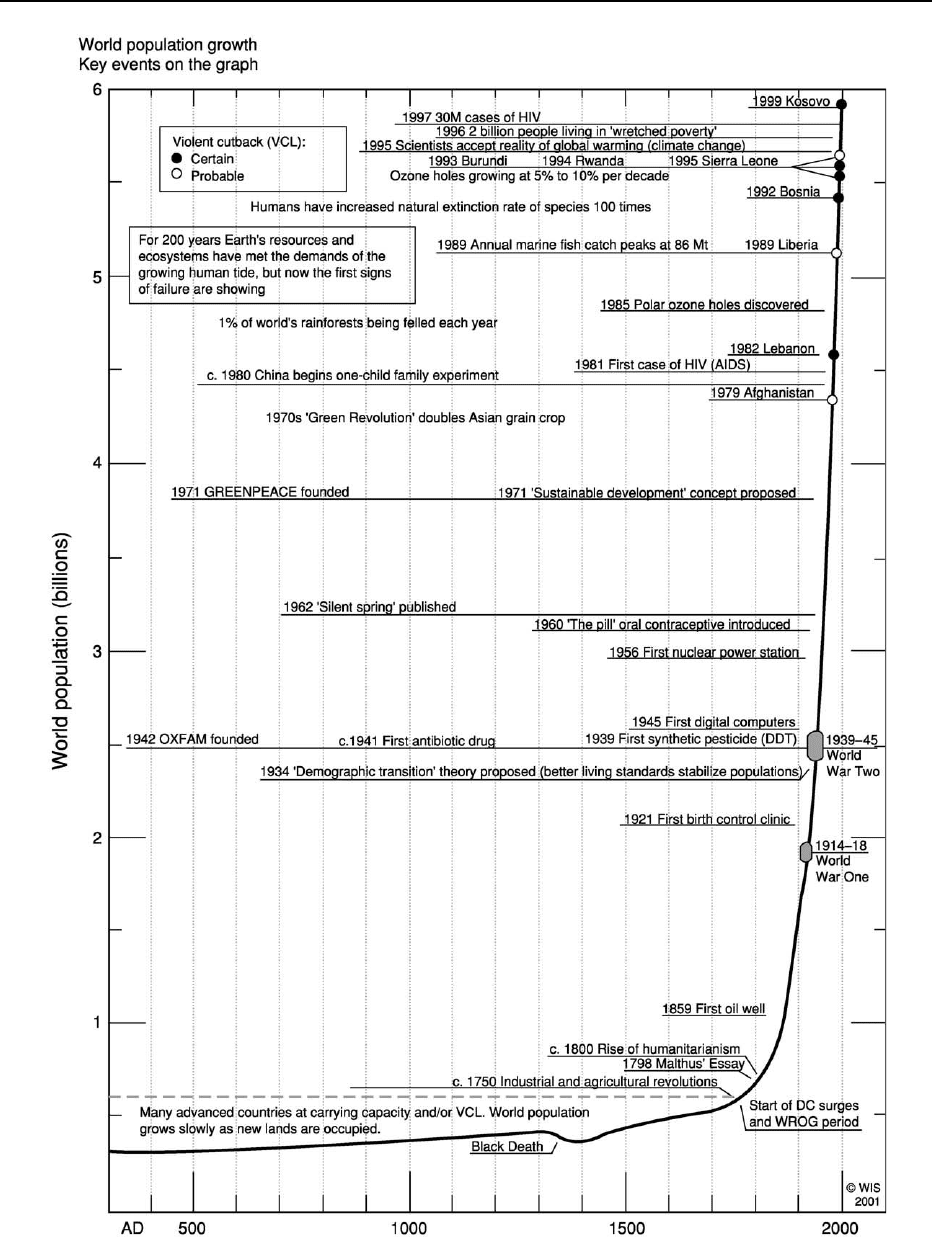
Figure 5 The escalation of the world population. After Stanton WI (2003) The Rapid Growth of Human Populations: 1750–2000. Brent-
wood: Multi-science Publishers.
ENGINEERING GEOLOGY/Natural and Anthropogenic Geohazards 521
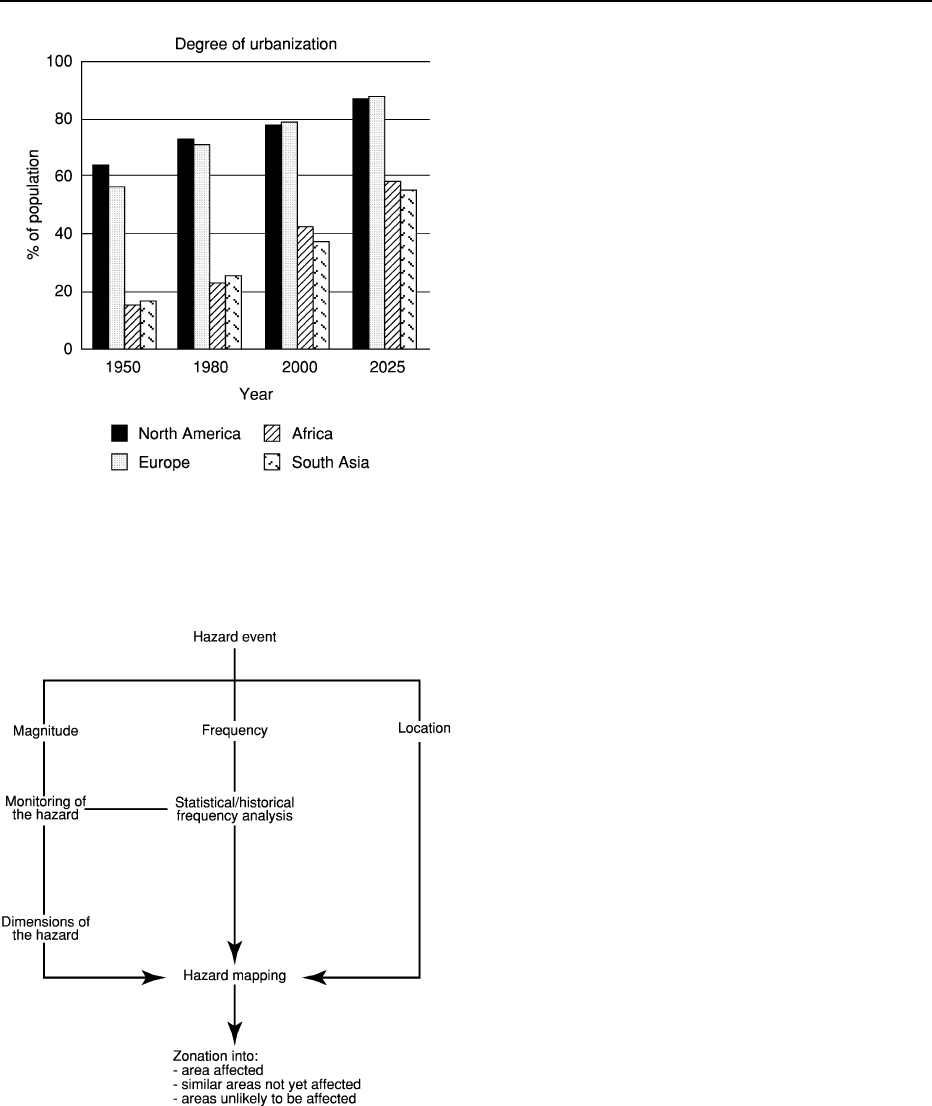
of past events (hazard rating). Evidence of past fail-
ures must be used to predict the likelihood of future
events, their scale, and frequency. Risk maps are quite
different in that they assess the potential losses that
may be incurred by society. They may involve
numerical quantification (for example, the table for
the Central Pacific by Blong RJ (1988)) (Table 3).
They may be followed by maps showing geo-
graphical divisions of recommended action (for
example, the map of Basilicata; Figure 8). Hazard
mapping may be very complex and involve numerous
maps of different type. For example, DKC Jones, in
1992, listed the following as all used in landslide
mapping:
.
geological structure;
.
chronostratigraphy of rocks;
.
lithostratigraphy of rocks;
.
lithostratigraphy of soils;
.
rockhead contours;
.
geotechnical properties of soils;
.
geotechnical properties of rocks;
.
hydrological conditions;
.
geomorphological processes;
.
geomorphological history, palaeodeposits, surfaces,
or residual conditions;
.
seismic activity;
.
climate (including precipitation);
.
ground morphology (especially slope height, length,
and angle);
.
land use;
.
vegetation type, cover, root density, and strength;
.
pedological soils, type and thickness of regolith;
.
past landslide deposits;
.
past landslide morphometry.
Wider Responses
JG Doornkamp listed four wider responses beyond
mapping considerations that can be adopted to miti-
gate hazards:
.
land use planning: place development in less haz-
ardous places;
.
economic planning: investment in the right places
and maintenance of financial reserves to cover
disasters; adequate insurance schemes;
.
development control: designing built structures to
cope with known hazards (e.g., earthquake-resistant
designs);
.
emergency planning: evacuation procedures to be
planned and rehearsed in all areas at risk from ma-
jor hazards; rescue teams trained and tested with
modern equipment, able to move quickly to the site
of a disaster.
Engineering and Geohazards
Experience has shown that geologists, on the one
hand, and engineers and developers, on the other,
Figure 6 The escalation of urbanization. After de Mulder EFJ,
in McCall GJH, de Mulder EFJ, and Marker BR (1996) Urban
Geoscience
. Rotterdam: Balkema.
Figure 7 The context of hazard mapping. After Doornkamp JG,
in McCall GJH and Marker BR (1989) Earth Science Mapping for
Planning, Development and Conservation, Engineering Geology Special
Publication No. 4
. London: Graham and Trotman.
522 ENGINEERING GEOLOGY/Natural and Anthropogenic Geohazards
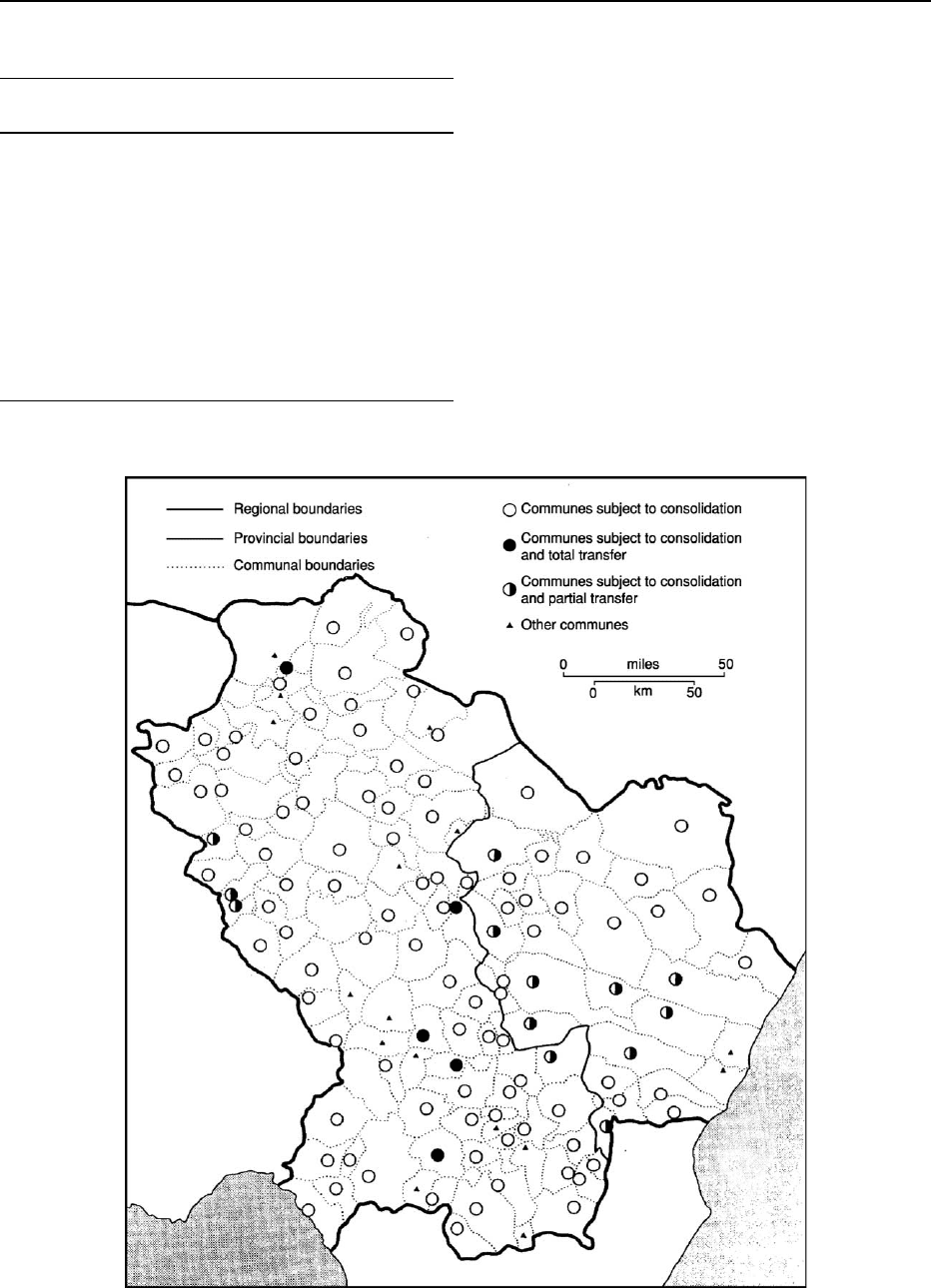
tend to have rather different viewpoints concerning
geohazards. The differences concern site investiga-
tion, which is the keystone of any engineering project.
There is a tendency amongst engineers and developers
to omit consideration of the hazards pertaining to a
particular site from previous site investigations, with
the view that the problems will only be addressed
if and when they arise. For the past three decades,
environmental geologists have stressed that these
factors must be evaluated as part of the previous
site investigation, and this is becoming, certainly in
the UK, a regulatory condition for construction and
development.
Engineers are greatly involved in investigation,
mitigation, and repair programmes related to both
natural and anthropogenic hazards. For example,
Figure 8 Landslide hazard assessment map, Basilicata, Italy. After Jones DKC, in McCall GJH, Laming DJC, and Scott SR (1992)
Geohazards – Natural and Man Made. London: Chapman and Hall.
Table 3 Geological risk rating for selected towns in Papua
New Guinea. After Blong RJ (1988)
Town
Earthquake
rating
Volcano
rating
Tsunami
rating
Risk
rating
Arawa 6 2 0.1 8
Daru 2 0.1 0.03 2
Goroka 5 0.1 – 5
Kavieng 3 0.1 0.1 3
Kiet 6 2 0.1 8
Kimbe 10 4 0.1 14
Kokopo 10 4 0.2 14
Lae 5 0.1 0.2 5
Madang 5 1 0.2 6
Mt Hagen 3 0.1 – 3
Port Moresby 3 1 0.01 3
Rabaul 10 5 0.2 15
Wewak 6 2 0.2 8
ENGINEERING GEOLOGY/Natural and Anthropogenic Geohazards 523

they design earthquake-proof buildings in Japan and
deviation works to prevent lava flows or lahars from
reaching villages and towns (as in Sicily). To illustrate
the variety of engineering applications to geohazards,
a list is given below of the types of work in which
engineers have been involved, and which are repre-
sented by reports to Special Publications of the
Engineering Group of the Geological Society:
.
liquefaction of sediments in the Fraser River Delta
(Canada);
.
flooding at Ladysmith (South Africa);
.
fluvial hazards (Bihar, India);
.
ice- and snow-related high-altitude problems in
glacial lakes (Himalayas, Peru);
.
cliff erosion (Isle of Wight, UK);
.
lessons from the Kobe earthquake (Japan);
.
risks from low-seismicity earthquakes (Holland);
.
gypsum-related subsidence at Ripon, Yorkshire
(UK);
.
subsidence related to solution in chalk (south-east
England);
.
groundwater recharge under rapid urbanization
(Mexico, Thailand);
.
organic solvent pollution of groundwater (Coven-
try, UK);
.
landfill disposal of urban wastes (Tanzania,
Gambia, Mauritius);
.
acid mine drainage (Transvaal);
.
heavy metal contamination (Cornwall, UK);
.
foundation conditions and site investigations (UK);
.
land restoration, brownfield sites;
.
detection of karst features by remote sensing
(England).
Conclusion
There have been great advances in hazard-related
earth science and engineering in recent decades, but
these hazards are far from understood and there is an
ongoing need for more data and statistics. Countries
such as China, with its immense population, many of
whom live in sites of high risk, and Colombia or
Nepal, where the climate and physiography militate
to give a situation in which natural geohazards are
quite unavoidable, but can be mitigated, if only by
emergency planning, are extreme examples; however,
no country is free from these problems. With the
growth of megacities, urban geohazards are assuming
increasing importance (Figure 6).
See Also
Engineering Geology: Liquefaction; Made Ground;
Problematic Rocks; Problematic Soils; Site and Ground
Investigation; Subsidence. Environmental Geology.
Soil Mechanics. Solar System: The Sun. Tectonics:
Earthquakes. Volcanoes.
Further Reading
Appleton JD, Fuge R, and McCall GJH (1996) Environ-
mental Geochemistry and Health, Special Publication
No. 113. London: Geological Society.
Blong RJ (1988) Assessment of eruption consequences.
Kagoshima International Conference on Volcanoes Pro-
ceedings, pp. 569–572.
Bullock P and Gregory PJ (1991) Soils in the Urban Envir-
onment. Oxford: Blackwell Scientific Publications.
Culshaw MG, Bell FG, Cripps JC, and O’Hara M (1987)
Planning and Engineering Geology, Engineering Geology
Special Publication No. 4. London: Geological Society.
de Mulder EFJ COGEOENVIRONMENT, International
Union of Geological Sciences (IUGS) (undated leaflet)
Planning and Management, the Human Environment –
the Essential Role of the Geosciences.
Maund JG and Eddleston M (1998) Geohazards in Engin-
eering Geology, Engineering Geology Special Publication
No. 15. London: Geological Society.
McCall GJH (2003) Global climate change – a view from
the floor. Geoscientist 13(6): 18–20.
McCall GJH, Laming DJC, and Scott SR (1992) Geoha-
zards – Natural and Man Made. London: Chapman and
Hall.
McCall GJH and Marker BR (1989) Earth Science Map-
ping for Planning, Development and Conservation, En-
gineering Geology Special Publication No. 4. London:
Graham and Trotman.
McCall GJH, de Mulder EFJ, and Marker BR (1996) Urban
Geoscience. Rotterdam: Balkema (see, especially, papers
by McCall, Simpson, and Mather).
Stanton WI (2003) The Rapid Growth of Human Popula-
tions: 1750–2000. Brentwood: Multi-science Publishers.
Thompson SA (1982) Trends and Developments in Global
Natural Disasters 1947–1981. University of Colorado
Institute of Behavioural Science Natural Hazards.
Research Working Paper No. 45.
Wang S (1997) Engineering Geology, Proceedings of the
30th International Geological Congress, Beijing, 1997.
Vol. 2–3. Utrecht: VSP.
Zhang Z, de Mulder EFJ, Liu T, and Zhou L (1997) Geo-
sciences and Human Survival, Environment, Natural
Hazards, Global Change. Proceedings of the 30th Inter-
national Geological Congress, Beijing, 1997. Vol. 2–3.
Utrecht: VSP.
524 ENGINEERING GEOLOGY/Natural and Anthropogenic Geohazards

Liquefaction
J F Bird, Imperial College London, London, UK
R W Boulanger and I M Idriss, University of
California, Davis, CA, USA
ß 2005, Elsevier Ltd. All Rights Reserved.
Introduction
Liquefaction-induced ground failure has caused
widespread damage and devastation; a recent exam-
ple is the closure of the Port of Kobe, Japan’s busiest
port, following the 17 January 1995 earthquake,
largely due to the liquefaction-related failure of
reclaimed land (Figure 1). The potential consequences
of liquefaction are far reaching, ranging from settle-
ment or tilt of individual building foundations to
the spread of fire when the water supply system is
damaged by permanent ground deformations.
Liquefaction is the loss of shear strength of a satur-
ated cohesionless soil due to increased pore water
pressures and the corresponding reduction in effec-
tive stress during cyclic loading. Liquefaction and its
associated ground deformation are very complex phe-
nomena, and the term ‘liquefaction’ has been used to
describe a wide range of soil behaviour. This article
focuses on the susceptibility, triggering, and conse-
quences of earthquake-induced liquefaction; liquefac-
tion caused by non-earthquake-related loading is not
included. Although the emphasis here is mainly the
liquefaction of saturated cohesionless deposits such
as sands or silty sands, it is important to consider that
strength loss in fine-grained soils under earthquake
loading can also pose a significant hazard. The assess-
ment of liquefaction hazard is an essential part of any
engineering project in seismic regions and is needed to
make informed decisions with respect to mitigation
options, foundation design, and emergency response
and recovery plans based on what is considered to be
an acceptable level of risk.
The Principles of Liquefaction
As a saturated cohesionless soil is cyclically loaded,
its particle structure can tend to collapse to a denser
arrangement. If the soil’s permeability and the site
stratigraphy are such that drainage cannot occur im-
mediately, then, as the collapse occurs, stresses will be
transferred from the soil grain contacts to the pore
water, leading to an increase in pore water pressure.
In simple terms, when the pore water pressure in-
creases, the effective stress (total stress minus pore
water pressure) on the particle structure will reduce,
and as it approaches zero, the shear resistance of the
soil will also approach zero. This loss of effective
stress and shear resistance is known as liquefaction.
The stress–strain behaviour of liquefying sand
depends strongly on its relative density. When loose
sand liquefies, the gravitational static shear stresses
may exceed the shear resistance of the soil and rapid
deformation with very large shear strains can com-
mence; this is referred to as flow deformation. The
soil behaviour is termed ‘contractive’, and the shear
resistance exhibited by the liquefied soil during flow
deformation is termed the ‘residual strength’. When
moderately dense granular soils are cyclically
sheared, pore pressures may similarly rise and lique-
faction can be triggered. However, rather than under-
going flow deformation, the soil particle structure
may try to expand as it reaches a certain level of
shear strain, resulting in what is termed ‘dilative’
behaviour. For undrained conditions, this leads to a
reduction in the pore water pressures and a corres-
ponding increase in effective stress and shear resist-
ance. A shear stress reversal, however, such as will
occur many times during earthquake shaking, may
cause the soil particle structure to be incrementally
contractive and the state of zero effective stress may
be temporarily reached once more. This continued
cycle of zero effective stress and strength regain is
termed ‘cyclic mobility’. The cumulative deforma-
tions can be significant, particularly if the duration
of shaking is long, but dilative soils do not exhibit very
large flow deformations in the way that contractive
soils do (Figure 2).
Figure 1 Liquefaction of reclaimed fills at the Port of Kobe in
1995 caused complete suspension of operations. The lateral dis-
placement of the quay walls in this picture pulled apart the crane
legs, causing collapse. Photograph by Leslie F. Harder, Jr.
ENGINEERING GEOLOGY/Liquefaction 525
